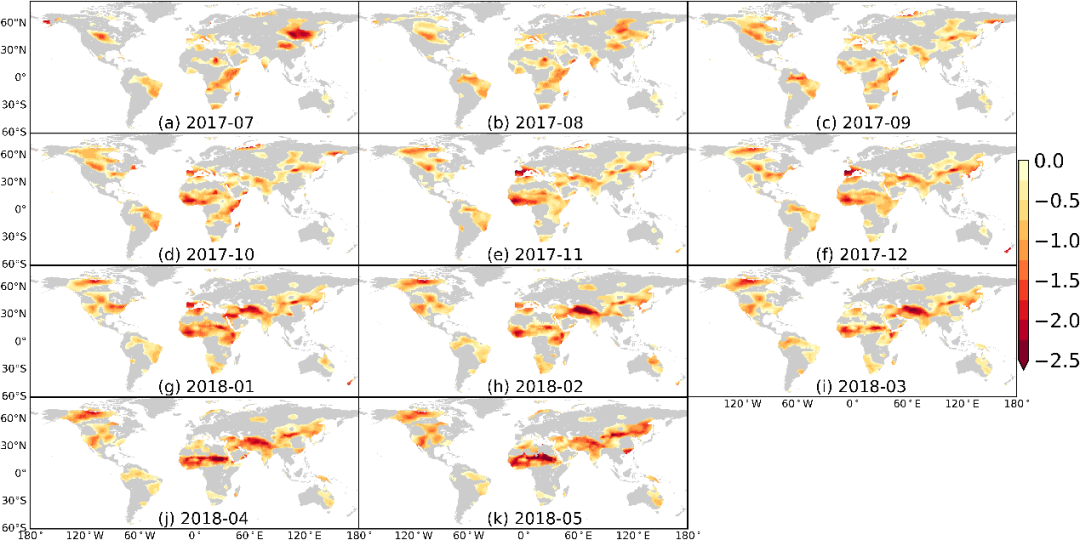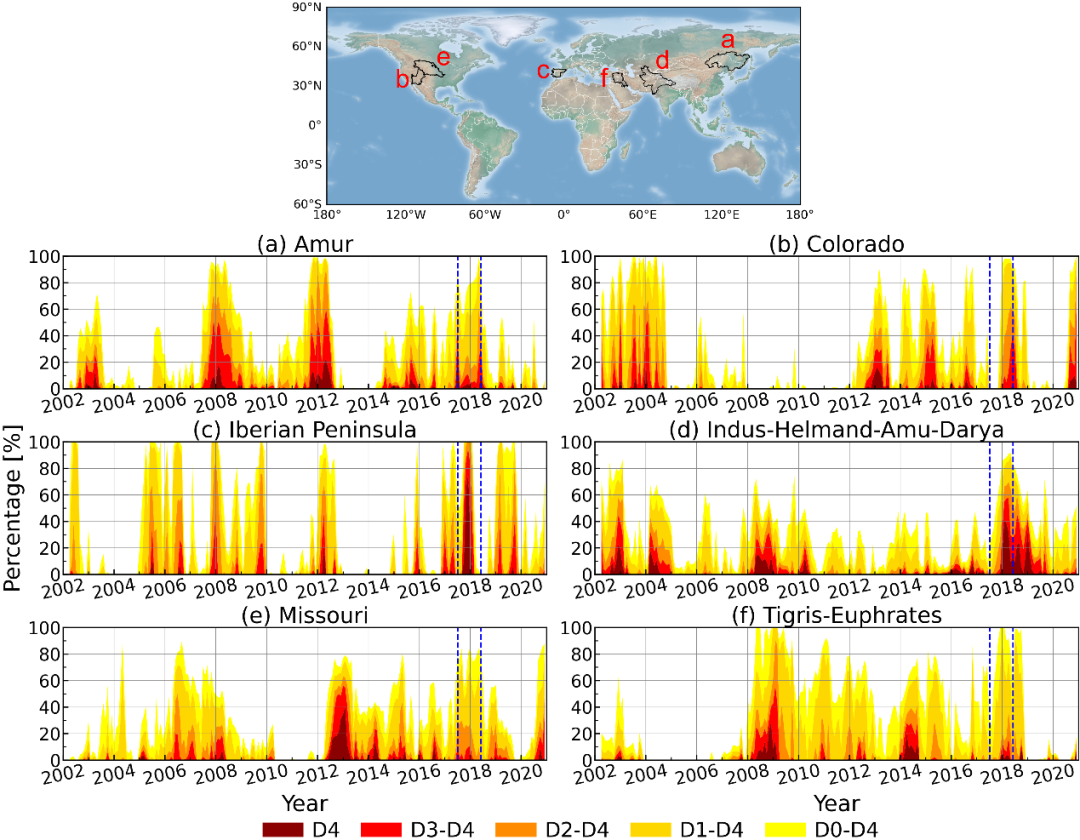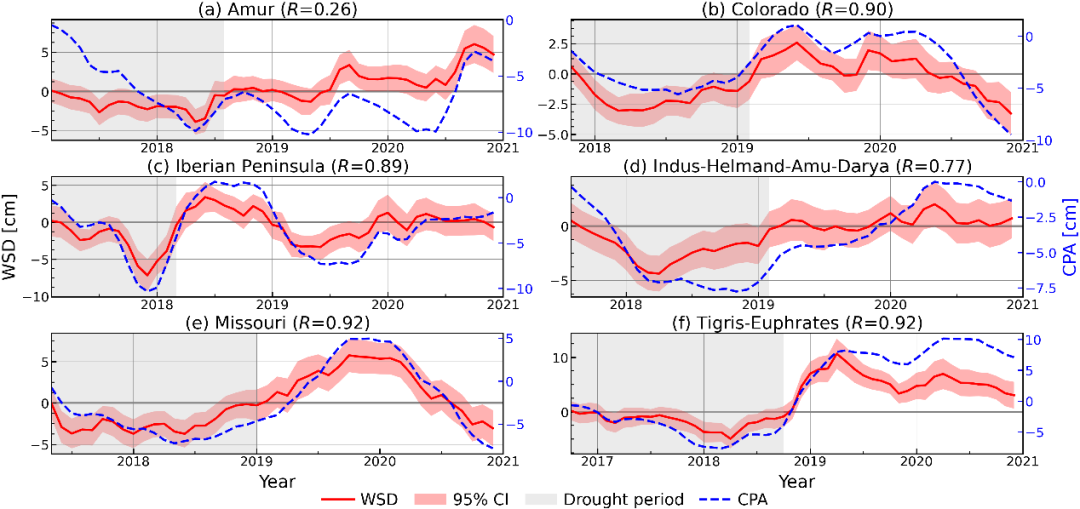WRR&JoH | GRACE(-FO) New Advances in Global Water Storage Signal Reconstruction and Hydrological Drought Studies for the 2017-2018 Observation Gap Period
Hydrological droughts (deficits in terrestrial water reserves) are usually formed by the further development and evolution of meteorological droughts (deficits in precipitation), and revealing their spatial and temporal evolution patterns, causes and recovery mechanisms is an important basis for disaster prevention and mitigation as well as water resources management. GRACE-FO (GRACE Follow-On) provides key data support for hydrological drought research by monitoring the spatial and temporal changes of global total land water storage. Since its launch in 2002, GRACE(-FO) monitored terrestrial water storage variability information has been widely used in global hydrological drought studies. However, due to the observation gap period between GRACE and GRACE-FO, there is about one year of missing global water storage observation data in 2017-2018, which affects the analysis of hydrological drought events with temporal overlap with that period. In addition, this observation gap also creates some uncertainties for other related applied studies, such as the simulation of global land surface/hydrological processes and the assessment of regional water cycle changes.
To address the above problems, a research team from the Department of Water Science, Nanjing University, in collaboration with domestic and international scholars from Sun Yat-Sen University, China University of Geosciences (Wuhan), Aalborg University, Denmark, and Nanjing Institute of Water Resources Science, developed a BCNN (Bayesian Convolutional Neural Network) deep learning method to combine satellite gravity, precipitation, temperature, and Hydrological simulations are used to reconstruct water storage changes during the GRACE and GRACE-FO monitoring gaps, and then quantify the spatial and temporal evolution patterns and causes of the global hydrological drought in 2017-2018.

Figure 1. distribution of the accuracy of the BCNN Nash efficiency coefficient NSE reconstruction calculated based on the GRACE(-FO) validation dataset (2014.4-2017.6; 2018.6-2020.12) (close to 1.0 is better)
As shown in Figure 1, except for a few extremely dry regions with low data signal-to-noise ratios (e.g., Sahara Desert, etc.), BCNN has Nash efficiency coefficients greater than 0.7 in more than 70% of the regions. Based on GRACE(-FO) observations and BCNN reconstructed water storage change data, further studies around the 2017-2018 global hydrological drought have led to the following new insights:
(1) Many regions in the global mid-northern latitudes experienced persistent hydrological drought during this period, including the northern part of China, the South Asia-Middle East-Southern Sahara belt, the Iberian Peninsula in Europe, and most of the United States (Fig. 2); meteorological and soil drought indices also indicate that these regions experienced drought conditions during this period, indirectly validating the reconstructed identification of hydrological drought;
(2) Further analysis of the hydrological drought characteristics of the six basins/areas within the drought zone revealed that they experienced moderate (D2), severe (D3), or exceptional drought (D4; Fig. 3) in 2017-2018, with droughts lasting 13-25 months and maximum water storage deficits that could exceed 50% of the seasonal fluctuations in storage;
(3) Hydrological droughts in all six basins mentioned above are mainly caused by persistent precipitation shortages, and the rates of drought spreading and recovery are significantly correlated with the rates of precipitation surplus and deficit accumulation (correlation coefficients up to 0.92); among them, the Iberian Peninsula (Figure 3c) and the Indus-Helmand River-Am River basin (Figure 3d) both experienced exceptional drought (D4) in 2017-2018, but the former experienced late drought in had faster accumulation of precipitation surpluses and faster recovery of water reserves, showing a stronger natural drought resistance potential.
(4) The hydrological drought in the GRACE(-FO) observation gap period has a continuous relationship with the drought before and after, and the peak of water storage deficit in the above six basins occurs in the observation gap period (Figure 3). Therefore, the reconstructed identification results of BCNN avoid the underestimation of misjudgment of the duration and intensity of the 2017-2018 hydrological drought.

Figure 2. spatial and temporal evolution of global hydrological drought based on standardized hydrological drought indices identified by GRACE(-FO) for the observation gap period 2017-2018

Figure 3. area share of occurrence of different classes of hydrological drought in six watersheds from 2002 to 2020, with the GRACE(-FO) filled by BCNN between the two dashed lines 2017-2018 observation gap period drought evolution process

Figure 4. water storage deficit (WSD) and cumulative precipitation spacing (CPA) in six watersheds during the 2017-2018 hydrological drought
This work reveals the spatial and temporal evolution of global hydrological droughts during the GRACE(-FO) observation gap, which provides important information for drought prevention and drought relief and optimal water resources management in relevant regions, and also provides basic data for further research on the evolution of hydrological droughts in the context of both climate change and human activities. BCNN can significantly improve the accuracy of GRACE(-FO) signal reconstruction compared with the traditional method, and effectively fill the missing data of global water storage change, which can be widely used in regional water storage change assessment and data assimilation of global land surface/hydrological process models.
The above results are presented as "Bayesian convolutional neural networks for predicting the terrestrial water storage anomalies during GRACE and GRACE-FO gap "and "Hydrological droughts of 2017-2018 explained by the Bayesian reconstruction of GRACE(-FO) fields", respectively. The latter is an improvement of the BCNN reconstruction framework based on the former and further focuses on the 2017-2018 global hydrological droughts.
Dr. Shaoxing Mo of Nanjing University is the first author of the paper, Prof. Jichun Wu is the corresponding author of the JoH paper, Prof. Xiaoqing Shi is the corresponding author of the WRR paper, and Prof. Wei Feng of Sun Yat-Sen University is the co-corresponding author; co-authors include Dr. Yulong Zhong of China University of Geosciences (Wuhan), Prof. Ehsan Forootan and Dr. Nooshin Mehrnegar of Aalborg University, Denmark, and Nanjing Xin Yin, PhD, Nanjing Institute of Water Resources Science. This research was jointly funded by the National Key Research and Development Program of China, the National Natural Science Foundation of China, the Second Comprehensive Scientific Expedition to the Tibetan Plateau, and the Postdoctoral Funds of China and Jiangsu Province.
Citation Format
1. Mo, S., Zhong, Y., Forootan, E., Mehrnegar, N., Yin, X., Wu, J.*, Feng, W.*, Shi, X., 2022. Bayesian convolutional neural networks for predicting the terrestrial water storage anomalies during GRACE and GRACE-FO gap. Journal of Hydrology, 604,127244.https://doi.org/10.1016/j.jhydrol.2021.127244
2. Mo, S., Zhong, Y., Forootan, E., Shi, X.*, Feng, W.*, Yin, X., Wu, J. (2022). Hydrological droughts of 2017-2018 explained by the Bayesian reconstruction of GRACE(-FO) fields. Water Resources Research, 58, e2022WR031997. https://doi.org/10.1029/2022WR031997
The BCNN code and reconstruction data used for this study are publicly available at:
Code: https://github.com/njujinchun/BCNN4GRACE
Data: https://zenodo.org/record/5336992



